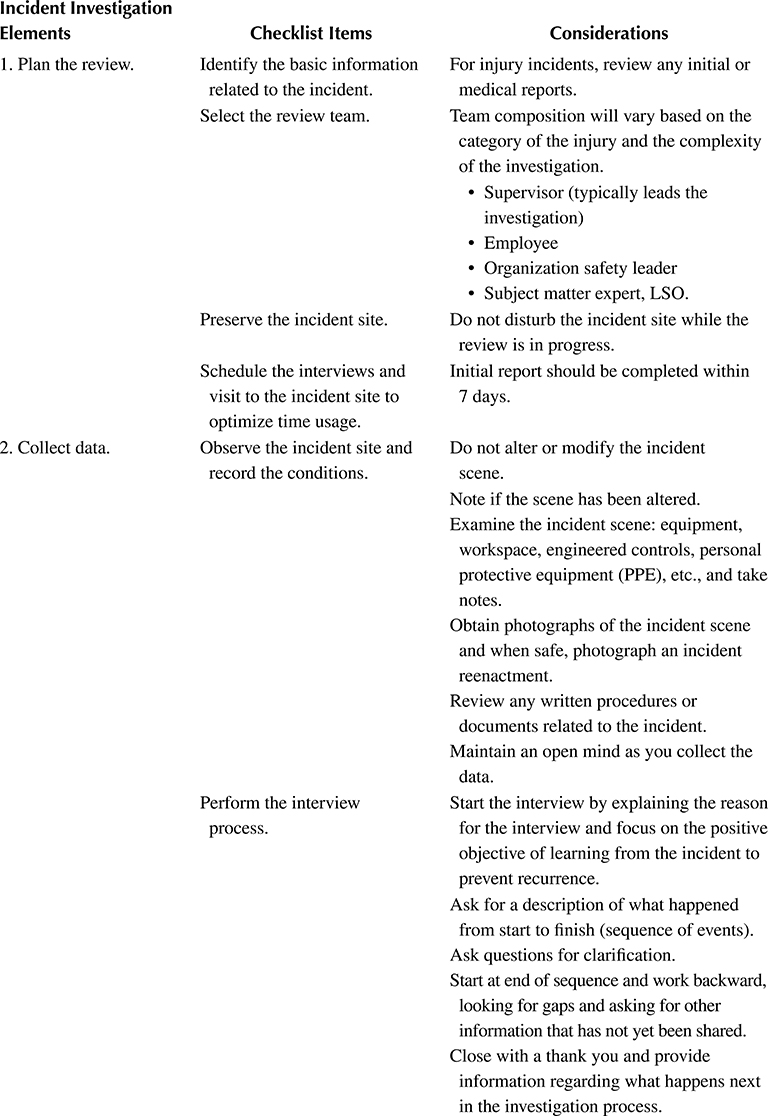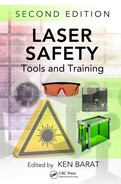13
Accident Investigation
Introduction
Although many efforts are directed to prevent laser accidents, we need to have a plan to follow in case an accident happens. One must be prepared to investigate an accident or incident as it is reported (see Table 13.1 for a simple checklist for a laser or any type of accident investigation). Most activities that include lasers are well-thought-out and include measures to prevent, or minimize the damage from a laser accident. For laser accidents in particular, one can take the advantage of this forethought to pinpoint what differed from plan and why as the strategy for conducting an accident investigation.
Who Should Lead The Accident Investigation?
The laser safety officer (LSO) should be the lead contact for a laser-related incident. Many LSOs wear several hats in addition to that for safety. Therefore, it might be necessary to turn the accident investigation over to another internal person or even an outside party. The ideal would be to have an investigation conducted by someone expert in accident causation; experienced in investigative techniques; and fully knowledgeable of work processes, procedures, persons, and industrial relations environment of a particular situation. Unfortunately, most of us live in the real world. Do not be afraid to call on any resources in your own firm.
The five basic components of an incident review are as follows:
Plan for the review.
Collect the data.
Assemble and review the data.
Identify causal factors.
Develop corrective actions.
Table 13.1
Simple Checklist or Flowchart for Laser or Any Type of Accident Investigation




The interview can be the most informative and challenging part of the entire process. Therefore, it is important to understand the five elements of the incident-review process: planning, data collection, assembly and review of data, performing causal analyses, and developing corrective actions.
Your focal point is to stay on point. Understand the incident so that recurrences are prevented.
Request a description of what happened (start to finish).
Ask questions for clarification.
Work backward through the sequence of events.
Look for gaps.
Ask for additional information that has not been shared.
Close with a thank you and follow-up information.
Typical interview questions are as follows:
What was the sequence of events and conditions leading up to and during the incident?
Was there anything abnormal or any recent changes?
Were there any work-around or task compensations?
Were there previous related occurrences?
Are there procedures, and how are they related to the incident?
What is the training status for the activity?
How much experience does the organization and individual experience with performing the activity in question?
Were there any contributing factors?
How could the incident have been prevented?
Special Note
One issue when interviewing the individuals involved is the common error of thinking you know what happened and asking questions to confirm that, be open-minded.
Interviewing is not a skill the LSO works on or is readily prepared for, hence it is worth repeating guidance on interviewing, so remember the following: Interviewing is an art, here are a few do’s and don’ts. The purpose of the interview is to establish an understanding with the witness and to obtain his or her own words describing the event.
DO’S…
Put the witness, who is probably upset, at ease.
Emphasize the real reason for the investigation, to determine what happened and why, not to find someone to blame or take the fall.
Let the witness talk, listen.
Confirm that you have the statement correct.
Try to sense any underlying feelings of the witness.
Make short notes or ask someone else on the team to get them during the interview.
Ask if it is okay to record the interview, if you are doing so.
Close on a positive note.
DON’TS…
Intimidate the witness.
Interrupt.
Prompt.
Ask leading questions.
Show your own emotions.
Jump to conclusions.
Ask open-ended questions that cannot be resolved by simply yes or no. The actual questions you ask the witness will naturally vary with each accident, but there are some general questions that should be asked each time:
Where were you at the time of the accident?
What were you doing at the time?
What did you see, hear?
What were the environmental conditions (weather, light, noise, etc.) at the time?
What was (were) the injured worker(s) doing at the time?
In your opinion, what caused the accident?
How might similar accidents be prevented in the future?
The LSO was not at the scene at the time, asking questions is a straightforward approach to establishing the incident. Obviously, care must be taken to assess the credibility of any statements made in the interviews. Answers to a first few questions will generally show how well the witness could actually observe what happened.
Factor Levels of Incidents
Causal factor: Any problem or issue that if corrected would have prevented the incident from occurring or significantly reduced the incident’s consequences. A causal factor is identified from the assembled data. It is the stopping point; and the physical and mental condition of those individuals directly involved in the event must be explored. The purpose of investigating the accident is not to establish blame against someone, but the inquiry will not be complete unless personal characteristics are studied. Some factors will remain essentially constant while others may vary from day to day: causal analysis of first-aid injuries. Few laser eye injuries fall into this group, but skin burns may.
Apparent cause: The most probable cause(s) that explains why the event happened, that can reasonably be identified, that local or facility management has control to fix, and for which effective recommendations for corrective action(s) to remedy the problem can be generated, if necessary.
Root cause: The most basic cause or causes that can reasonably be identified that management has control to fix and when fixed will prevent (or significantly reduce the likelihood of) the problem’s recurrence. For each cause category, one or more basic causes are identified. For each basic cause, one or more root causes are identified (stopping point for causal analysis for Occupational Safety and Health Administration [OSHA] recordable injuries).
Corrective action: A change (in procedure, policy, equipment, etc.) that, when implemented, corrects the identified causal factor or root cause and thereby prevents (or significantly reduces the likelihood of) the incident from recurring. Corrective actions shall be SMARTER:
Specific
Measureable
Accountable
Reasonable
Timely
Effective
Reviewed
This model of accident investigations provides a guide for uncovering all possible causes and reduces the likelihood of looking at facts in isolation. Some investigators may prefer to put some of the sample questions in different categories; however, the categories are not important, as long as each pertinent question is asked. Obviously, there is considerable overlap between categories; this reflects the situation in real life. Again it should be emphasized that the above sample questions do not constitute a complete checklist, but are examples only.
What About Management?
Management always has the legal responsibility for the safety of the workplace and therefore the role of supervisors and higher level management, so management systems must always be considered in an accident investigation. Failures of management systems are frequently found to be direct or indirect factors in accidents. Ask questions such as the following:
Were safety rules communicated to and understood by all employees?
Were written procedures and orientation available?
Were they being enforced?
Was there adequate supervision?
Were workers trained to do the work?
Had hazards been previously identified?
Were unsafe conditions corrected?
Was regular maintenance of equipment carried out?
Were regular safety inspections carried out?
User Response: Do They Have An Action Plan?
One needs to have a plan in place in the event of a laser accident. While our efforts are directed to prevent laser accidents, one needs to have a plan to follow in case an accident happens. More importantly, laser users need to know what that plan is. One solution is to place in every laser work area a poster that provided the names and current phone numbers of emergency personnel and steps to be followed until help arrives. A posted page or section in the laser procedure manual is recommended. The sample poster represented next could also be prepared as a Web page. The advantage of the Web page approach is that it can provide quick updates, such as phone numbers and personnel changes. A disadvantage is that it may not be thought of during the excitement of the moment.
General Guidance for Suspected Eye Injury
Keep the individual calm.
Preferably keep the individual seated or lying down; avoiding panic or shock is the main goal.
Call for assistance.
If your institution has a central help number for emergencies, call that number. Otherwise, have the number of the local trauma center available; do not count on using or finding the phone book.
If you have a medical clinic on-site, it can be called or notified. If medical facility or security is called first, they should have standing instructions to contact the LSO.
It is important that the medical facility has some understanding of laser eye injuries as well as the laser mechanism.
Transport the person to a medical facility.
Many large organizations have a fire department or security force that would transport the individual; these individuals should be instructed on how to handle a person with an eye injury.
Notifications: Notify the individual’s or the area supervisor along with the LSO and others working in the same area or on the same equipment.
Medical Facility: Do They Have An Action Plan?
Depending on your community, you may have limited choices of where to send an individual with a suspected laser eye injury. It is important that the facility has some understanding of laser eye injuries as well as the laser mechanism. Commonly, once the individual informs the medical staff that he or she works with or around lasers, any injury, particularly retinal, will be assumed to be laser induced. Medical personnel may overlook the fact that many other optical causes or diseases could be the reason for visual problems or defects. Provide the name of a retinal specialist to the individual for further evaluation or follow-up in cases involving visible or near-infrared laser radiation. Not all laser injuries have an immediate effect on vision; consequently, initial and follow-up eye examinations are critical.
